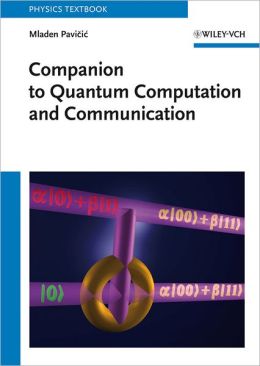 [内容简介]
[内容简介]
This is a timely, self-contained introduction to the rapidly expanding field of quantum information and computation that avoids detailed mathematical proofs wherever possible. The author uses a mixed exposition between a popular and technical approach, connecting the standard results of the field with more recent developments.
A complete but not highly technical textbook for students of physics, mathematics, and computer science.
[目录]
Foreword VII
Preface XIII
1 Making Computation Faster and Communication Secure: Quantum Solution 1
1.1 Turing Machine: a Real Machine or . . . 1
1.2 . . . a Mathematical Procedure 2
1.3 Faster Super-Turing Computation 4
1.4 Digital Computers Do Not Run on Logic 5
1.5 Speeding up Computation: Classical Analog Computation . . . 9
1.6 . . . vs. Quantum Physical Computation 14
1.7 Complexity Limits: Exponential Time 17
1.8 Energy Limits . . . 23
1.9 . . . and Reversible Gates 27
1.10 Ultimate Efficiency: Quantum Computers and Qubits 32
1.11 Combining and Measuring Qubits: Quantum Superposition – Qubit Primer 35
1.12 Generating Qubits: Sources of Photons – Polarization Primer 49
1.13 Correlating Unpolarized Qubits: Quantum Entanglement 56
1.14 Separating and Transforming Entanglements: Bell States at a Beam Splitter 66
1.15 Manipulating and Verifying Entanglements: Superdense Coding 76
1.16 Copying Qubits? No. Teleporting Qubits! 93
1.17 Unperformed Measurements Have no Values: Kochen–Specker Sets 110
1.18 Controlling Qubits: Quantum Gates and Circuits 130
1.19 Self-Sustaining Qubits: Quantum Error Correction 141
1.20 Flying Qubits Connecting Quantum Chips and Computers: Quantum Repeaters 149
1.21 Why Classical Cryptography Cannot Keep Secrets for Long . . . 151
1.22 . . . and Why Quantum Cryptography Can? 157
1.22.1 Entanglement in Action: Deterministic Communication 161
1.22.2 No-cloning in Action: Probabilistic BB84 Protocol 166
1.23 Why There Can Be No Quantum Eavesdroppers? Unconditional Security 169
2 Quantum Computation and Communication Hardware 175
2.1 Technological Candidates forQuantum Computation Implementation 175
2.2 All-Optical Scalable Quantum Computation 179
2.2.1 Probabilistic Parity Check Gate with a Quantum Encoder 180
2.2.2 Destructive CNOT Gate 183
2.2.3 Nondestructive Probabilistic Full CNOT Gate 186
2.2.4 The Teleportation Trick 188
2.2.5 Scalable Computation 191
2.3 Trapped Ions 192
2.4 Nuclear Magnetic Resonance 208
2.5 Silicon-Based Nuclear Spins – Kane’s Computer 215
2.6 Quantum Dots 223
2.6.1 Energy-Level Design; Quantum Dots in a Microcavity 226
2.6.2 Atom–Cavity Interaction between Levels j0i and j1i 227
2.6.3 Laser–Atom Interaction between j0i and j1i 227
2.6.4 Atom–Cavity and Laser–Atom Interactions between j0i and j2i 228
2.6.5 Implementation of a CNOT Gate 228
2.6.6 Reading out the Results; Perspectives 230
2.6.7 Spin-Level Design; Array of Coupled Quantum Dots 231
2.7 Superconducting Devices 235
2.7.1 Josephson Junction 238
2.7.2 Josephson Junction Circuit and Hamiltonian 239
2.7.3 Josephson Junction Cooper-Pair Box 240
2.7.4 Superconducting Quantum Interference Device – SQUID 240
2.7.5 Cooper Pairs 241
2.7.6 Quantum Gates for Single Qubits 243
2.7.7 Quantum Gates for Two Qubits – CNOT Gate 246
2.7.8 Reading out the Results 249
3 Melting Theory with Implementation 251
3.1 Quantum Network 251
3.1.1 One-Atom Laser and Atom–Cavity Coupling 251
3.1.2 Single Photons on Demand 252
3.1.3 Dark States 253
3.1.4 Quantum Repeaters Revisited 261
3.2 Quantum-Classical Coupling: Interaction-Free Computation 266
3.3 Quantum Algorithms: Quantum or Classical Problems? 281
3.3.1 Are there Universal Quantum Algorithms? 281
3.3.2 Quantum Coin – Deutsch’s Algorithm 282
3.3.3 Deutsch–Jozsa and Bernstein–Vazirani Algorithms 284
3.3.4 Shor’s Algorithm 287
3.3.5 Quantum Simulators 292
4 Beyond Standard Qubit Computation 297
4.1 Persistent Entanglement 297
4.2 One-Way Computing and Cluster States 298
4.2.1 Dumping Reversibility and Unitarity? 298
4.2.2 Irreversible Measurement Setup 299
4.2.3 Reversibility and Unitarity Revisited 301
4.3 Continuous Variables 302
4.3.1 Continuous Entanglement 303
4.3.2 Second-Order (One-Photon) vs. Fourth-Order (Two-Photon) Interference 303
4.3.3 Qubits with Continuous Spatial Degree of Freedom 304
4.3.4 Universal Quantum Computation with Continuous-Variable Cluster States 306
5 Epilogue – Hybrid Systems 307
List of Figures 309
List of Tables 313
References 315
Index 331

 新书报道
新书报道